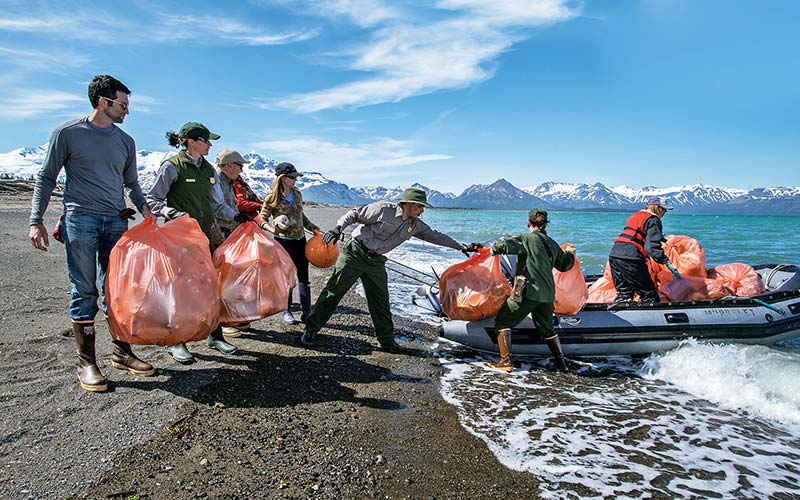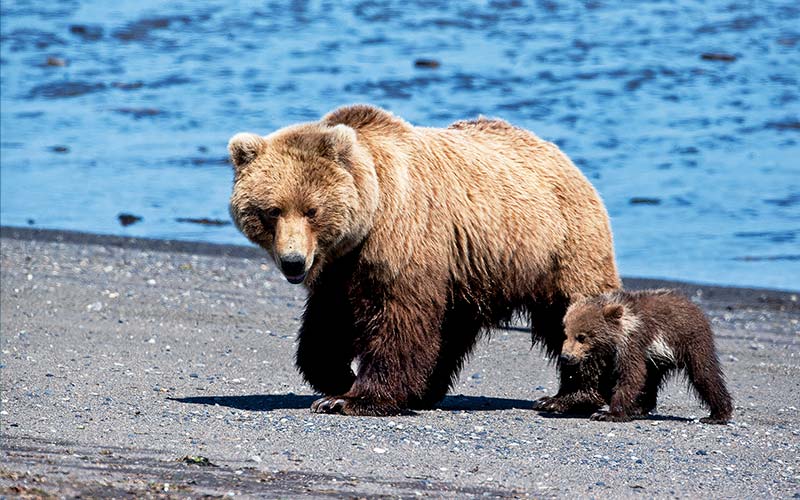I had just begun to feel a little uncertain about the spot where I was standing, so I moved back. The grizzly bears had apparently decided to walk around us, but they stayed very close — no more than 15 feet away. The cubs were having trouble seeing us as they strolled by, so they stood on their hind feet to improve their view. My camera’s motor drive whirred away, and one of the cubs began to climb up its mother. When it suddenly emerged on her back, we all just melted.

It was June 2013, and I was documenting a unique expedition called Gyre, a weeklong cruise covering some 450 miles of Alaska’s southwest peninsula. The expedition was sponsored by the Alaska Sea Life Center and The Anchorage Museum, and its purpose was to highlight the huge problem of plastic in our ocean and to help influence human behavior through art. Other organizations involved with the expedition included The National Oceanic and Atmospheric Administration (NOAA), The Smithsonian Institution, Ocean Conservancy and National Geographic.
Alaska Sea Life Center project visionary Howard Ferren spent years planning the trip. “The ultimate goal is to reach new audiences, influence attitudes about consumption and waste and ultimately to change behaviors that are fundamentally the cause of marine debris,” Ferren said.
I was relishing the opportunity to explore this remote territory — not only with my camera but also with an incredible group of people. Gyre’s participants included scientists, filmmakers, a teacher and artists, and all shared the same mission: to highlight the striking contrast between the rugged beauty of Alaska and the thousands of tons of trash that are spit out of the North Pacific Gyre onto Alaskan beaches each year.

From February through September, 2014, The Anchorage Museum is featuring an exhibit called Gyre: The Plastic Ocean, which presents works of art made from garbage collected during the expedition. Artist Pam Longobardi collected scores of fishing floats, which are now part of her installation at the exhibit. Said Longobardi, “Plastics are the cultural archaeology of our time. They don’t belong in the ocean, and the tremendous, conscious force of energy that is the ocean does everything it can to expel this material and vomit it back onto the beach to show us the wrong we have done.”
Most of our days were spent on isolated beaches that can only be reached by floatplane or small boat. Some were expansive and contained thousands of massive logs. Others were tiny and contained no logs at all. We found debris ranging from huge fishing nets to plastic bottles from Japan. On one beach we found hundreds of college football flyswatters destined for fans across the U.S. On another we came across a massive ball of packing straps. In Alaskan waters, packing straps account for 50 percent of Steller sea lion entanglements. A strap slowly sawing its way into the neck is a horrific way to die.
After a week at sea we had visited nearly a dozen locations including Gore Point, Point Blank, Shuyak Island and Afogneck. Along the way, Ocean Conservancy biologist Nick Mallos collected 831 brightly colored bottle caps, more than half of which originated on the other side of the Pacific. According to Mallos, “sea birds like albatrosses often mistake plastic bottle caps for food. They take them back to their chicks, which ingest them and perish from gastrointestinal blockage and, ultimately, starvation.”

During the final two days we visited an isolated area called Hallo Bay, which is part of Katmai National Park. Hallo Bay is a remote area, but it received an influx of debris from the 2011 Japanese tsunami. It’s also famous for grizzly bears — park biologists estimate that some 2,200 live in Katmai.
Before we arrived Katmai rangers had collected more than 4,000 pounds of trash from the dunes and beach. Some of this garbage had been chewed on by bears. According to park superintendent Diane Chung, “Bears are very fascinated by the marine debris, especially plastic floats. Although we haven’t documented any deaths, we are concerned about the bears being exposed not only to the plastics but also to the toxins such as lead that often coat these items.”
Our visit to Hallo Bay was timed to remove this trash and take it back to Seward. It took our team nearly 13 hours to load everything with the park service, which left only one day to explore this beautiful area. Until then we had only seen bears from only a distance, but Hallo Bay delivered the encounter with a mother and her curious cubs that none of us would ever forget.

Slowly the bears walked away and we were left in astonished silence. It was incredibly moving, and some people were even weeping. I had never planned on coming face to face with a grizzly during my trip to Alaska, but encounters like this one change people and remind why we protect wild places. They also motivate us to get involved — for the sake of the sea life, the bears and our own legacy on this planet.
© Alert Diver — Q2 Spring 2014